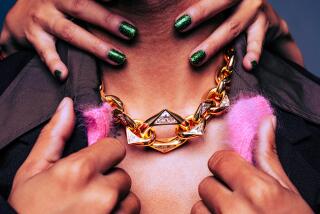What you should know about pearls
- Share via
Pearls are the perfect example of modern jewelry reinvention. They’ve been a feminine go-to for centuries, and the traditional, mid-20th century “Jackie O” pearl strand is trending again — but now with endless re-interpretations and much modern flair. Mixed with various metals, stones and gems, re-done in endless styles, sizes, colors, shapes and prices, the majestic pearl is resurging in its chicness.
“I absolutely love creating jewelry with pearls,” says Cynthia Bach, a Los Angeles designer who works often with exotic pearls. “Pearls have always had a mystique and glamour but now there is impressive new energy in the market. It’s really quite exciting for those of us who are big pearl fans.”
And these lovely gems are not just for women, either, adds New York jewelry designer Mish Tworkowski, who also creates many of his pieces using pearls. “I wear a pair of pearl cuff links almost every day. My favorite set is made from an irregularly shaped pair of huge, light blue South Sea baroque pearls. People are constantly asking me what they are.”
Pearls are so-called organic gems, because they are made by living creatures. A pearl forms inside the soft tissue of a living shelled mollusk when the animal reacts to grit by coating it with concentric layers of crystalline calcium carbonate called nacre, or mother-of-pearl.
Until the early 20th century, natural pearls were the only pearls to be had. Highly valuable, they were priced accordingly and so extremely rare, it’s said Pierre Cartier, a grandson of the Cartier founder, traded a strand of natural pearls he collected over decades for the 5th Avenue property of Cartier’s New York store.
Now there are also cultured pearls, made when humans introduce the irritant that causes the mollusk’s protective process to begin. These too can be pricey since farming them can be an expensive proposition. The Cultured Pearl Assn. of America says a farmer can expect to spend $100 for every oyster, and many will fail to produce or will die before the end of a 5-to-10-year production cycle.
Pearls may grow in saltwater or fresh, and there are many types within those two categories. The main saltwater pearls are Akoya, South Sea and Tahitian.
Akoya pearls, grown in Japan, were the first cultured pearls and are what most people traditionally envision when they think of pearls: round, white and iridescent. South Sea pearls are harvested mainly in Australia, Indonesia, India and the Philippines and can grow much larger than Akoya pearls; they’re generally golden or white hues. Tahitian “black” pearls come from French Polynesia and their dark colors range from black to purple, blue, gray, silver, aubergine (eggplant), peacock (black and green) and pistachio.
Naturally created orange and pink pearls are popular in Asia and rising in popularity in the U.S., says Bach.
Orange melo melo pearls grow in the Indo-Pacific seas, especially near Vietnam, and come from the marine bailer snail. They’re an unusual papaya-mango hue. The iridescent flames sometimes found on the pearl’s nacre are called Dragon flame. Extremely rare, only one out of about 30,000 snails produces a melo melo pearl.
Conch (pronounced konk) pearls, or “pink” pearls, generally come from the Caribbean. They grow naturally in the Queen Conch shell and are especially popular in China, says Bach. One out of about 10,000 conches will produce a pink pearl. She says they’re especially popular in Asia because the pink hue of the pearl complements Asian skin tones exceptionally well.
Most freshwater pearls are today grown and harvested in China, and in the past decade the Chinese have created freshwater pearls of a huge variety of colors (determined by the minerals in the cold-water lakes where they are farmed, Bach says) and sizes (determined by the size of the mollusk implanted). They come in many shapes other than round and in a luscious variety of natural pastel colors, including white, cream, strawberry, lavender, apricot and rose.
Keshi, or seed, pearls (Keshi means poppy seed in Japanese) are the smallest pearls and are spit out from the host before full formation. Mabe, or blister, pearls form when the irritant is attached to the host’s shell and develops with one flat side.
There are numerous pearl shapes, but the traditional include round, semi-round, oval, pear, drop, button, baroque and ringed.
When you buy a piece of pearl jewelry, price — and value — depends on how well the pearls are matched and on their size, shape, nacre thickness, color, luster and clarity.
“Something magical happens when you place a strand of pearls on your neck,” says Kathy Grenier, marketing director for the Cultured Pearl Assn. of America, based in Rhode Island. “It might be different for each person, nonetheless the feeling is real, magical and transforming. The pearls become a part of you; they absorb your warmth, your spirit, the blueprint of you. When you remove the strand from your neck there is a lingering warmness you can actually feel in the pearl. It is said that each pearl has a soul…. I believe this to be true.”






